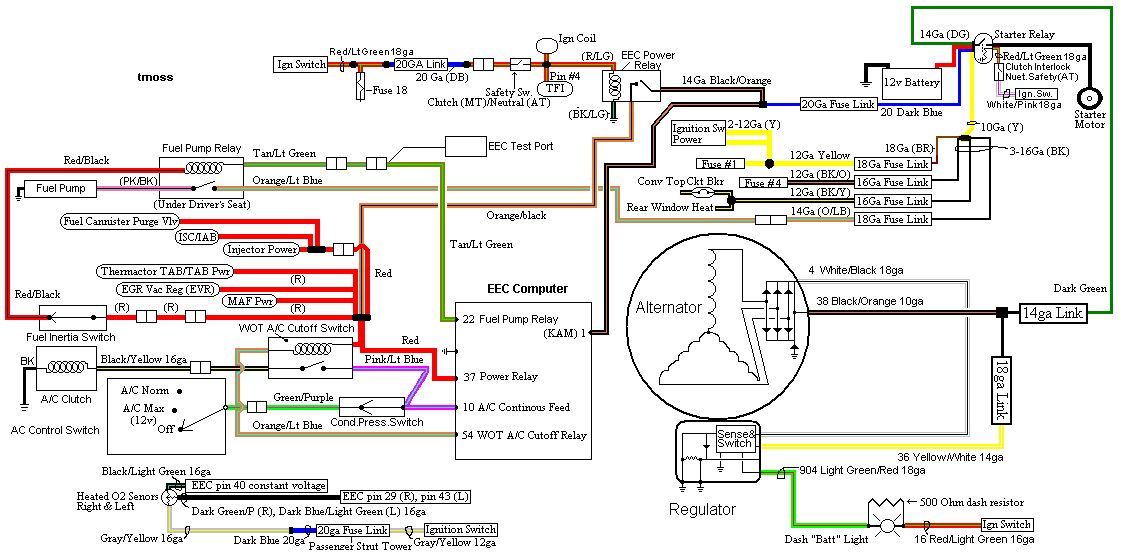I've had this problem ever since i completed my 5.0l swap from 2.3l... The fuel pump doesn't turn on when ignition is in the on position or starting position ( tested for no pressure at fuel rails) yet the motor sparks just fine in start position.. attempts to start, crank turns... whole deal.
I have been at college all year and I just returned to finish my project... tomorrow will be my first day tackling it again... just want some pointers while i try and find where its failing.
-car details-
current car 89 lx
motor/tranny/fuel tank/ecu from 91 gt
motor harness from 89 gt ( switched when i realized the difference )
I have heard the inertia switch is something to check but last time i checked it, it seemed to be fine (last year). I have heard things such that it could be the fuel pump itself just not working but i doubt it since it came from a car that was t-boned so i assume it was running at time of impact. I also made sure the connector to the fuel pump was securely fastened. At the time of the swap I accidently lost track of the wires that go on the two terminals... some sort of power distrubtor (drivers side next to the coil). I followed a book to put them back so i assume they are right.. but maybe not? Also when I was doing the heater core swap... which btw is a fun project... i ended up messing up the ignition switch that mounts to the key cylinder.. its a small white box (mounted on an angle)... but since I had a parts car that i stripped i went over and found the gt one which was laying outside and put that in... needless to say last time i checked the electric windows and mirrors which failed to work also... post-swap problem, possibly a related problem?
now... does this switch(ignition) go bad if it gets wet or sits outside for sayyyy 8 months ?... if so how can i test if it to prove that it is my problem? Also any other tips to check along the way... i have heard to check voltages along the wire to the fuel system... ie ( under the drivers side seats before/after, inertia switch before/after, wire to pump )... anyone know what the normal voltage ratings should be there?
?... if so how can i test if it to prove that it is my problem? Also any other tips to check along the way... i have heard to check voltages along the wire to the fuel system... ie ( under the drivers side seats before/after, inertia switch before/after, wire to pump )... anyone know what the normal voltage ratings should be there?
anything else i should check before i go crazy following wires all over? any ideas??
I have been at college all year and I just returned to finish my project... tomorrow will be my first day tackling it again... just want some pointers while i try and find where its failing.
-car details-
current car 89 lx
motor/tranny/fuel tank/ecu from 91 gt
motor harness from 89 gt ( switched when i realized the difference )
I have heard the inertia switch is something to check but last time i checked it, it seemed to be fine (last year). I have heard things such that it could be the fuel pump itself just not working but i doubt it since it came from a car that was t-boned so i assume it was running at time of impact. I also made sure the connector to the fuel pump was securely fastened. At the time of the swap I accidently lost track of the wires that go on the two terminals... some sort of power distrubtor (drivers side next to the coil). I followed a book to put them back so i assume they are right.. but maybe not? Also when I was doing the heater core swap... which btw is a fun project... i ended up messing up the ignition switch that mounts to the key cylinder.. its a small white box (mounted on an angle)... but since I had a parts car that i stripped i went over and found the gt one which was laying outside and put that in... needless to say last time i checked the electric windows and mirrors which failed to work also... post-swap problem, possibly a related problem?
now... does this switch(ignition) go bad if it gets wet or sits outside for sayyyy 8 months
anything else i should check before i go crazy following wires all over? any ideas??



 If you used a voltmeter instead
If you used a voltmeter instead 